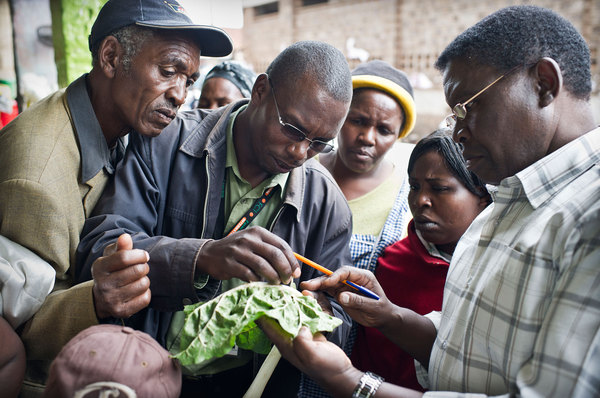Slicing Into The Bread Wheat Genome
Bread wheat (Triticum aestivum) is a globally important crop that accounts for 20% of the calories consumed by the world’s human population. Major work is underway to increase wheat production by expanding knowledge of the wheat genome and analysing key traits, however due to the large size and great complexity of the bread wheat genome…
Watermelon Genome Could Hold the Key to Improved Varieties With Fewer Pest Problems
A research team led by the Beijing Academy of Agriculture and Forestry Sciences have produced the complete genomic sequence of watermelon (Citrullus lanatus). It is hoped that the genomic data from this study will shape future research into watermelon genetics and provide a good resource for crop genetics and future plant breeding projects, resulting in…
Plantwise Plant Clinics in Trinidad and Tobago
Trinidad and Tobago Country Coordinator Shamela Rambadan sent the photo below of a Soursop (Annona muricata) plant brought into a clinic in County Victoria in Trinidad and Tobago by farmer Ramesh Ramnanan last month. The symptoms described included yellowed, distorted leaves and visible insects on the leaves, as seen in the photo. Plant health officer…
Bean and Gone – Controlling the Coffee Berry Borer Using Integrated Pest Management
The Coffee Berry Borer, Hypothenemus hampei, is a tiny beetle which is widely considered to be the most damaging pest of coffee plantations in the world. Originating in Africa, it is now found in almost all coffee growing areas in the world as an invasive species, with nearly 160 records from different areas worldwide on…
Colorado Potato Beetles Left With A Sour Taste As Clover Is Found To Be As Effective As Pesticides
Eggplant or aubergine (Solanum melongena) is a crop often attacked by the Colorado Potato Beetle (Leptinotarsa decemlineata), a major insect pest of plants from the Solanaceae family including potato, tomato and eggplant throughout North America, Europe and Asia. This insect pest is exceptionally destructive to crops and readily develops resistance to a wide variety of…
Plant Pest Interactions: How Soybean Aphids Trick Soybean Plant Defences
Following on from a previous blog on the interactions between soybean plants and soybean pests, new research on soybean (Glycine max) responses to the soybean aphid (Aphis glycines) published in Molecular Plant-Microbe Interactions has revealed some of the complex and fascinating interactions between pests and their plant hosts. This recent research led by Dr Gustavo Macintosh and…
Sweet Like Chocolate: Breeding Programs Combating Fungal Diseases of Cocoa in Ecuador
Cocoa, Theobroma cacao L. is the third most important export product in Ecuador; a country which produces 70% of the world’s highly prized Arriba cocoa. However, the sustainability of this crop is threatened by a number of devastating pest species including fungal diseases and insect pests. Among the most severe are the closely related fungal diseases…
Earthworm-farmer friendship, redefined
Earthworms are known as farmers’ best friends because of the multitude of services they provide that improve soil health and consequently plant health. The density of earthworms in the soil is considered to be a good indicator of a healthy soil because they improve many soil attributes like structure, water holding capacity, moisture content etc.,…
Weaving a web of crop protection
Spider-Man was perhaps the first to demonstrate the full effects of a spider bite: crime-fighting superpowers. But now it’s the turn of cereal crops to benefit. The Grains Research and Development Corporation (GRDC) in Australia is looking into the possibility of using spider venom as an insecticide – a potentially safe, environmentally friendly, and sustainable pest control…
Stopping Striga before it’s started
Striga, or witchweed, is the main weed affecting many cereals including rice, maize, sorghum and millet. One species, Striga hermonthica, is responsible for more crop loss in Africa than any other individual species of weed. Striga is a hemi-parasitic weed; its roots latch onto the roots of its host (e.g. a crop plant such as…
- « Previous
- 1
- 2
- 3
- 4
- Next »


